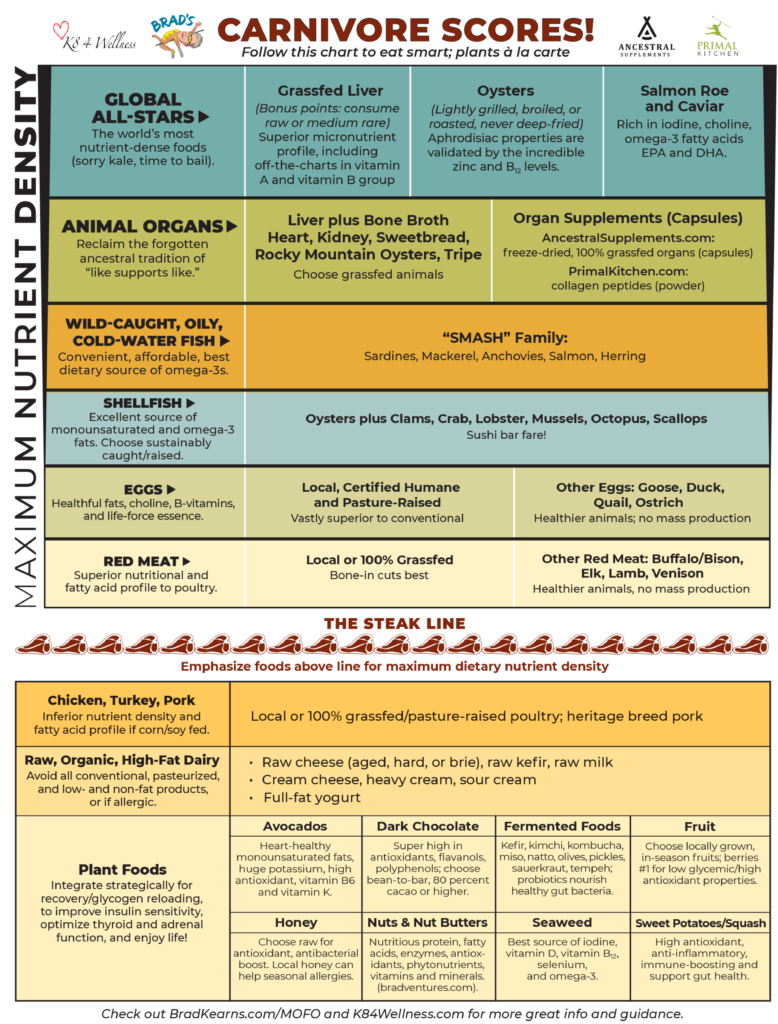The carnivore diet has exploded in popularity as people realize maximum nutrient density and satiety come from animals and that certain plant foods/many plant foods can trigger inflammatory or autoimmune reactions due to natural antigens aka anti-nutrients. It also has gained ardent followers in those who have discovered the significant improvements they’ve experienced in both athletic performance and recovery (specifically with decreasing inflammation and stiffness post-workout).
Check out AncestralSupplements.com, BradKearns.com, and K84Wellness.com for more great info.
However, not all animal foods are created equal. While a bunch of people are celebrating carnivore success with just eating steak and burgers, most of the benefits are likely being derived from what they are excluding, rather than the magical mystical powers of store-bought hamburgers as a superfood. Striving for a nose-to-tail experience with maximum variation in your consumption of animal foods can dramatically elevate the health benefits, reduce risk of deficiencies that might arise from a carnivore approach that is extremely narrow (since you are already narrowing your food choices so much). Introducing organ meats into your diet means adding in a wide variety of foods that all contain a superior nutritional profile in comparison to the popular go-to protein option of many, aka muscle meat.
If you want to indulge or eat extra, go for the protein. Not all protein sources are created equal, so this guide highlights the differences between protein sources so you can make informed choices. If you’re a fish fan, you’ll learn why it’s healthier to consume sardines as a staple and larger, oily fish like salmon, less frequently. Also, be careful about new buzzwords, like the current of-the-moment word ‘pasture-raised,’ because it’s not the end all. Go for the Farmer’s Market as your first choice, or do a little research into local companies to find the best option for your budget. Also, remember that the process of getting organic certification is not inexpensive, and you’ll probably discover there are some farmers and companies in your area who are doing everything naturally and organically, but just don’t have the official certification yet.
A Note About Dairy
If you have no symptoms of: acne, skin abnormalities, headaches, swollen joints, joint pain, headaches, gas, or bloating, then grassfed and organic dairy products are a great source of protein, fat, vitamins, and minerals. Additionally, many people who are sensitive to cow dairy find that goat dairy, which contains more essential fatty acids than cow dairy, and is also rich in zinc and Vitamin D, is much easier to digest. If you are sensitive to lactose specifically, but still can consume some dairy products, stick with options that are either low in lactose or lactose-free, like most aged, hard cheeses (and surprisingly, brie), and fermented products like yogurt.
A Note About Fish
It’s certainly not wise to ignore concerns about heavy metal toxicity in certain fish nor the potential problems of eating industrialized farmed fish. Oily-fleshed, cold-water fish, in general, are the best option, both in terms of nutrient profile and sustainability and pollutants. Plus, as a nice added bonus, SMASH fish (Sardines, Mackerel, Anchovies, [Wild-Caught] Salmon, and Herring) also tend to be the most affordable. Shellfish are also a good option, specifically clams, crab, lobster, mussels, oysters, shrimp, and scallops, which have high levels of zinc, magnesium, and B12. Generally, try to source your fish from remote, pollution-free waters, although a few farmed options may be considered ok (mussels, scallops, oysters, catfish, tilapia, and domestic trout). However, this is only if they have been raised in a sanitary environment, as this indicates that their nutritional profiles will be similar, though not as impressive, as their wild counterparts. When it comes to what to avoid, stay away from farmed, imported, processed, endangered fish, as well as fish on the top of the food chain, like shark, swordfish, marlin, king mackerel, and large tuna, as these carry the most toxicity concerns. You can also check out the Marine Stewardship Council (msc.org) and MontereyBayAquarium.com for more details on what has been approved, and what to avoid.
Click Here To DOWNLOAD Carnivore Scores Chart
LINKS AND RESOURCES:
- Certified humane pasture-raised best egg
- Choline benefits
- Chris Kresser on the risks of raw milk
- Conventional vs raw dairy
- Dairy contaminants
- Egg rankings
- Egg terminology explained
- Farmed Atlantic salmon 90%
- Farmed salmon dirty
- Fermented dairy benefits
- Fish egg benefits
- Marine Stewardship Council
- Mercola fish dangers
- Organic milk cleaner than dairy
- SeafoodWatch.org National Guide
- Seafood Health Alerts – great major ranking chart.
- Signs and causes of leaky gut syndrome
- Smithsonian fish rankings
- Tuna brand ranking









